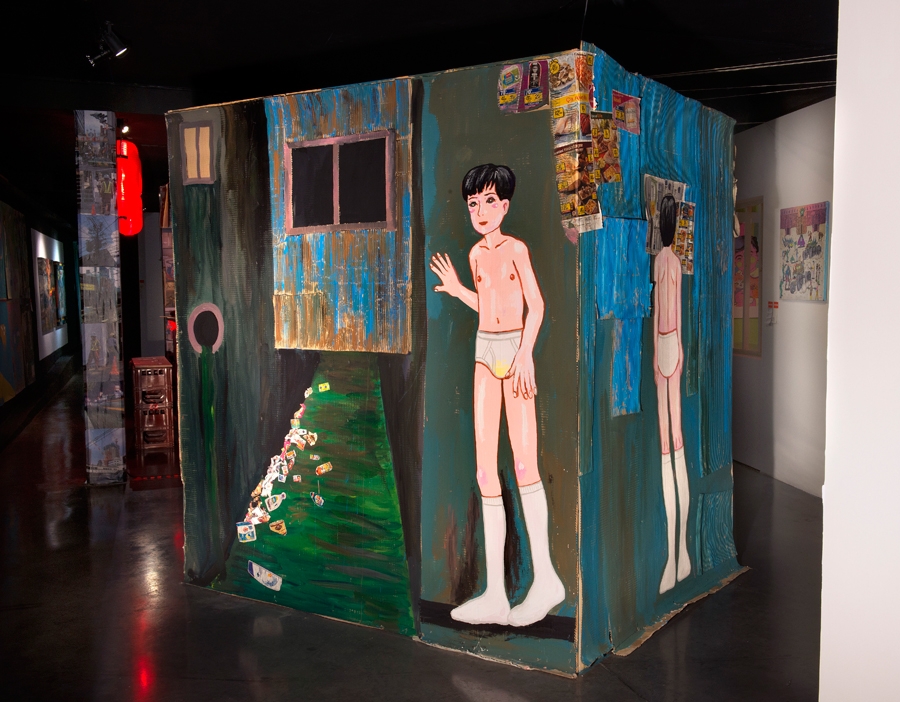Back in the posthippy, prepunk early 1970s in Japan, Yumura Teruhiko was the trailblazer of a consciously raw, handmade and apparently craftless graphic style, for which he coined the term ‘heta-uma’, broadly ‘unskilled-skilled’, or ‘bad but good’. Rejecting the period’s empty polish and inhuman perfectionism, ‘heta-uma’ was a much-needed injection of Pop art brut. Yumura rejoiced in exuberant scrawling and collage, often embracing yet subverting imported American ideals from romance comics or musclebuilding adverts. Under the mock-Westernised pen names ‘Terry Johnson’ or ‘King Terry’ from ‘Tokyo Funky Studio’, his covers and comics appeared in the monthly manga magazine Garo. Founded in 1964, this peaked at around 80,000 copies (still very modest compared to massmarket titles) as an influential though unpaid outlet for politically and socially engaged comics creators. But by the dawn of the 1970s its role and relevance began to change amid the decline in student activism and Japan’s accelerating economic boom. Yumura’s radical artwork heralded Garo’s shift towards artists eager to express themselves through highly idiosyncratic .styles and narratives, like Nemoto Takashi’s delirious ‘ero-guro’ or erotic grotesque faragos, and Shiriagari Kotobuki’s Zen-like absurdism. Nemoto hailed Yumura: “He opened many doors and allowed in artists who were not very strong technically but had a soul to express.”
Rejecting the period’s empty polish and inhuman perfectionism, ‘heta-uma’ – translated as ‘bad but good’ – was a much-needed injection of Pop art brut
Forty years later, three generations of these artists, all more or less a§liated with the ‘heta-uma’ avant-garde, have found themselves finally brought together for their first two-part group show, oddly not in their homeland but in two arts institutions in France. One reason for this French connection, as Tsuzuki Kyoichi, Japanese commentator and collector from Roadsiders’ Weekly, explained at the opening is: “You cannot do this exhibition in Japan, because the Japanese artworld doesn’t care about this kind of popular culture, so they see ‘heta-uma’ is not supposed to be art, this is manga comic business or illustration business, not fine art.” Another factor is that outside of Asia, France is the largest consumer of translated manga. While sales are dominated by commercial hits, many French publishers also release more auteur or underground manga as featured in this double exhibition.
It also helps that French artist Hervé Di Rosa, a key figure with his brother Richard and Robert Combas in the ‘Figuration libre’ movement since the 1980s, was hugely inspired by discovering Yumura’s work in 1979. Di Rosa o«ered to host this exhibition in the Musée International des Arts Modestes (or MIAM, French for ‘yummy’), in his native Sète on the Mediterranean coast, a repository, showcase and generator that he cofounded in 2000 for works on the peripheries of art brut, Outsider art and popular culture. As cocurators, Di Rosa turned to Pakito Bolino, artist and dynamo behind wild silkscreen publishers Le Dernier Cri, who brought in Ayumi Nakayama from Tokyo bookshop and publisher Taco Ché. Together they expanded the project into two parallel shows, adding Mangaro into gallery space La Friche Belle de Mai, a former Gauloise cigarette factory turned multiarts venue, and Dernier Cri’s base in Marseilles.
Godfather Yumura sadly did not attend the opening, but some 30 artists aged between twenty-five and sixty came over from Japan, many meeting their peers for the first time, to work on new pieces inside the two spaces, from massive wall paintings to installing crazy, crude structures, part-shed, part-shrine. Kago Shintaro concocted bleakly humorous sex-toys gaudily packaged like joke novelties, while Tanaami Keiichi loaned some of his eye-popping kimonos. Far from being ‘unskilled’, artists like Maruo Suehiro or Hanawa Kazuichi demonstrate dazzling precision, channelling draughtsmanship from past masters, while among the striking young artists are members of graphic magazines Mograg and Erect, and twin sisters Arizono Eru and Emu, who collaborate as Hamadaraka. Contextualising these, hanging from MIAM’s ceiling, are remarkable relics rescued by Tsuzuki Kyoichi – lurid original banners promoting Japan’s former travelling freakshows, one of which promises a pair of cows with the heads of Elizabeth Taylor and Elvis Presley.
Dense, intense and disturbing, much of the contents of these two landmark exhibitions comes from the cultural margins, unmoored from moral conventions or the propriety of Japan’s aestheticised self-image. This is what these fierce, uncompromising creators can bring, in participant Imiri Sakabashira’s view: “Japan has been traumatised by disasters throughout its history: war, nuclear, earthquakes. Consumer society wants to make us forget them, but many of these artists are expressing through their work this deep trauma.”
This article was first published in the Spring 2015 issue of ArtReview Asia.
